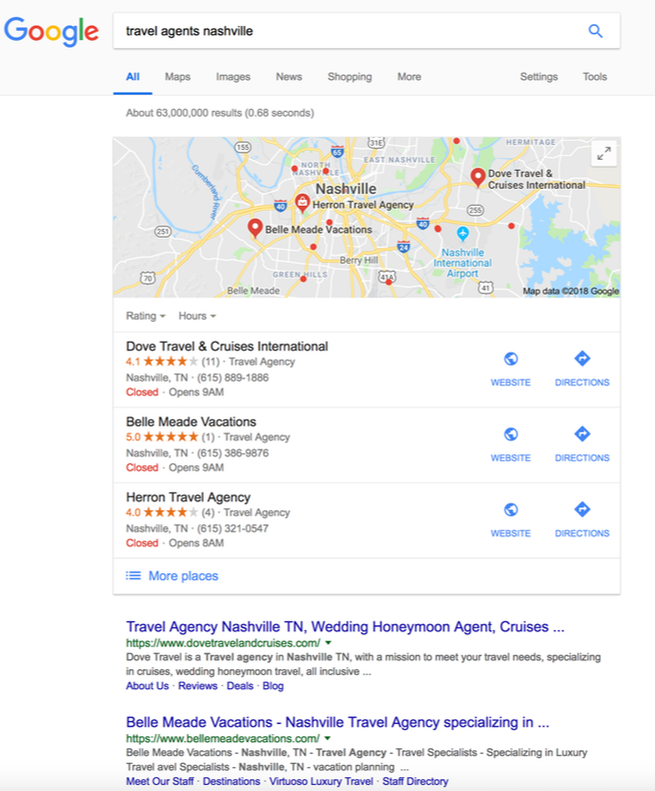Backlinks are simply links from a third party site to your own. The more authoritative the site linking to you, the higher ranking the search engines give your article. In fact, my Ireland article mentioned in Part 1 was linked to by USA Today, which helped its search results enormously.
 One of the best ways to generate backlinks is to find other website owners who will trade links with you. For example, the local yoga studio you attend might be willing to trade links to expose their clients to your clients and vice versa. Guest blog for each other or guest blog for a travel site. Get an article of yours published locally, by a newspaper or chamber of commerce. And, of course, develop links from your social media accounts. Lists of travel agents are particularly strong, so sign up for supplier directories and be sure to list your site. However, the backlinks should be from sources that are authoritative. It is a questionable technique used by some “blackout” SEO firms to create “link farms” where they place links without any relevance to good content simply to create a backlink. Google and other search engines will penalize your site’s SEO ranking for this type of spurious effort.
One of the best ways to generate backlinks is to find other website owners who will trade links with you. For example, the local yoga studio you attend might be willing to trade links to expose their clients to your clients and vice versa. Guest blog for each other or guest blog for a travel site. Get an article of yours published locally, by a newspaper or chamber of commerce. And, of course, develop links from your social media accounts. Lists of travel agents are particularly strong, so sign up for supplier directories and be sure to list your site. However, the backlinks should be from sources that are authoritative. It is a questionable technique used by some “blackout” SEO firms to create “link farms” where they place links without any relevance to good content simply to create a backlink. Google and other search engines will penalize your site’s SEO ranking for this type of spurious effort.
Practice Exercise:
Reach out to some local retailers in your area and work out a link exchange. Remember to treat the arrangement as a mutually beneficial effort. You might each write an article for the other, or you may simply include each other in a list of local businesses to patronize.
Site Maps
Some systems like Voyager Websites, build sitemaps automatically. There are plug-ins for WordPress Sites. If you have a custom-built site, there are programs on the market that will build a site map for you and you can then register the site map with Google using the instructions in the additional reading materials provided below.
Note that site maps are really just another way of presenting your navigation system to be crawled by the search engines but are not as necessary for simple sites as they are for more complex sites.
Additional Reading:
Build and Submit a Site Map to Google
Listing your business with Google
 List your business with Google! When you do, you will begin to show up on their local ad spots like this one. Remember, many consumers are likely to conduct a search just as I have done here “Travel Agents Nashville” so you want to ensure you come up on the list locally as well.
List your business with Google! When you do, you will begin to show up on their local ad spots like this one. Remember, many consumers are likely to conduct a search just as I have done here “Travel Agents Nashville” so you want to ensure you come up on the list locally as well.If you have a storefront travel agency, it is possible to link your website, address, and a map, to your agency’s listing. Contrary to what many home-based agencies believe, however, it IS NOT necessary to list an address. Home-based businesses can list a service area instead.
Once your business is listed with Google Local Search, your company name will be in a list of similar businesses when someone makes a search on your locality.

Exercise: List with Google My Business
List your business with Google by working through the information here:
https://support.google.com/business/#topic=4539639
Keyword Analysis
Google provides a free tool to do such analysis with their Keyword Planner:
https://ads.google.com/home/tools/keyword-planner/

Exercise:
Using Google’s Keyword Planner, search for good keywords for your own niche markets and for articles you are going to write. Then, when you write a blog post, when you do a Facebook Post when you write an article, use your key words in a natural fashion to make the search engines take notice of your writing when someone searches using the keywords!



